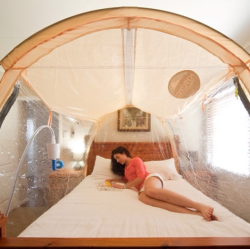
Athletes are best at a height of 2000-2500 meters sleep during one "Live-high-train-low" Training in a high altitude tent. At this altitude the conditions are most favourable to perform as well as possible afterwards at sea level. This has been shown by a group of researchers with a great deal of experience in altitude training.
Live high train low altitude training
Altitude training has been the subject of research for a long time. Many athletes go on altitude training once or even several times a year or stay at an artificial altitude to improve their sports performance. Swimmer Joeri Verlinden, for example, stays in a so-called altitude tent. He trains in the Netherlands with Martin Truijens, who has a PhD in altitude training.
The live-high-train-low principle (LHTL) is one of the most common forms of altitude training to improve endurance performance at sea level. In this type of altitude training, athletes stay at altitude but training takes place at "sea level". The idea behind this is that an athlete at "sea level" can carry out training at normal intensity. The remaining time that athletes spend at altitude can cause physiological changes that can have a positive effect on endurance performance. Chapman and fellow researchers have studied at what altitude athletes should stay during an LHTL training session for optimal performance enhancement.
Ideal height is 2000 to 2500 meters
They examined 45 trained athletes (both men and women) of 21 years on average and with a VO2max of approximately 62 ml.kg / min. The athletes are divided into 4 groups that stayed at different heights for 4 weeks. A group stayed at 1780 m, a group at 2085 m, a group at 2454 m and a group at 2800 m. All athletes trained together. The training sessions took place between 1250 and 3000 m, with the intensive training sessions taking place at 1250 m. The VO2max, the time it took for athletes to run 3000 m on an athletics track and the volume of red blood cells were determined before, immediately after and 2 weeks after the height training period.
Before the height training period started, the 4 groups did not differ from each other on the above parameters. Only in the groups that stayed at 2085 and 2454 m were the VO2 max and the performance improved immediately after and 2 weeks after the LHTL training period. The VO2max increased by just over 3% in these groups, while the running time on the 3000 m improved by 2%. In all 4 groups, the volume of red blood cells was increased by approximately 6% after the height training period. Two weeks after returning, this positive effect disappeared.
Conclusions
The research by Chapman and colleagues shows that during a Live High Train Low training placement athletes can best stay or sleep in an altitude tent at an altitude between 2000 and 2500 m. At this altitude the conditions are most optimal to end up at sea level to achieve a substantial performance improvement.
As you may know, there are also athletes who respond less well to altitude training. This is also apparent from this study. Although the majority of athletes staying between 2000 and 2500 m performed better and the average effect was positive, it turned out that 2 athletes from these groups started to perform worse. That is why it remains important to determine individually whether height internships are an effective means of improving performance.
Chapman RF, Karlsen T, Resaland GK, Ge RL, Harber MP, Witkowski S, Stray-Gundersen J, Levine BD (2013) Defining the “dose” or altitude training: how high to live for optimal sea level performance. J. Appl. Physiol. , In Press DOI: 10,1152 / japplphysiol.00634.2013
